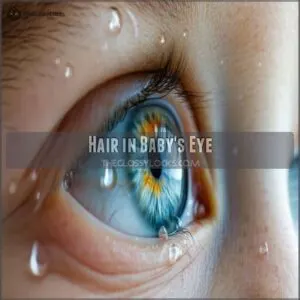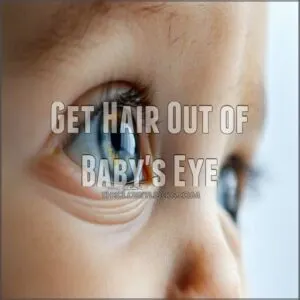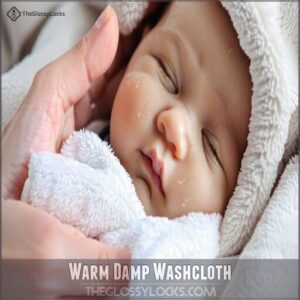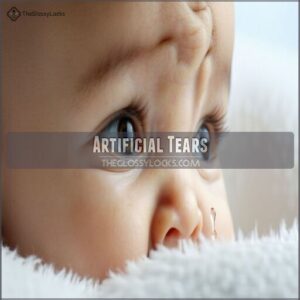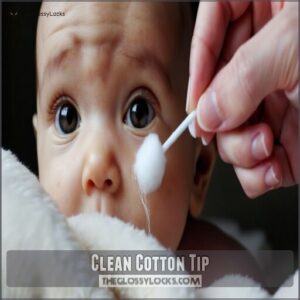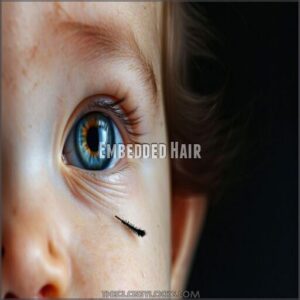This site is supported by our readers. We may earn a commission, at no cost to you, if you purchase through links.
 Getting a hair out of a baby’s eye might feel nerve-wracking, but it’s usually simple. First, wash your hands—clean hands are key.
Getting a hair out of a baby’s eye might feel nerve-wracking, but it’s usually simple. First, wash your hands—clean hands are key.
Grab a warm, damp washcloth and gently wipe near the eye, letting the moisture help loosen the hair. If the hair’s stubborn, a drop of artificial tears can help flush it out (just make sure they’re baby-safe).
Whatever you do, don’t poke or press on their eye—it’s more delicate than a bubble. If the hair won’t budge or there’s redness or tears, check with a doctor. A little patience goes a long way, and your baby’s eye will thank you, with a gentle approach being the key.
Table Of Contents
Key Takeaways
- Wash your hands first and use a warm, damp washcloth to gently wipe near the baby’s eye, letting moisture loosen the hair.
- If the hair doesn’t budge, use preservative-free artificial tears to flush it out safely.
- Avoid poking or pressing on the eye; a light touch and patience are key.
- Call a doctor if the hair causes redness, swelling, or discomfort that doesn’t improve.
Hair in Baby’s Eye
It’s common to spot a tiny hair or eyelash in your baby’s eye, and it can feel a bit alarming at first.
Thankfully, their eyes are pretty good at handling it on their own with a few blinks or some natural tears.
Common Occurrence
Spotting a hair in your baby’s eye can feel nerve-wracking, but it’s surprisingly common.
Babys hair often drifts into their eyes during cuddles or playtime. Luckily, their natural blinking and self-cleaning eyes usually handle it.
While it might trigger a bit of parental anxiety, most hairs work their way out without fuss. Think of it as the eye’s built-in debris removal system, which is a natural part of their self-cleaning eyes, and it’s also a surprisingly common occurrence.
No Visible Irritation
If the hair in your baby’s eye isn’t causing visible irritation, it’s often best to leave it.
Babies have self-cleaning eyes, and natural blinking usually clears things up.
Monitor closely for redness or discomfort, but avoid unnecessary intervention.
Gentle eye cleaning isn’t needed unless symptoms appear, and minimal intervention is key to safe and effective baby eye care.
Natural Removal Process
Babies’ eyes are little self-cleaning machines. Thanks to tear production, blinking reflexes, and natural hydration, they often handle things like a hair in the eye all on their own.
Babies’ eyes work like self-cleaning wonders, naturally flushing out tiny irritants with tears, blinking, and effortless hydration.
- Blinking helps flush objects away.
- Tears naturally clean irritants.
- Eye movement shifts the hair.
- Hairs often vanish within minutes.
- Small issues rarely need intervention.
Babies’ eyes are capable of self-cleaning and often resolve small problems without assistance, making intervention rarely necessary.
Get Hair Out of Baby’s Eye
Even tiny hairs can look like a big problem regarding your baby’s eyes.
Luckily, there are safe removal techniques that don’t need to be stressful. First, resist the urge to panic—your baby’s natural tears are a big help in dislodging the hair.
If the hair in the baby’s eye doesn’t move after a few minutes, consider simple home remedy options like sterile saline drops or gently wiping the corner of the eye with a clean, warm, damp washcloth.
Baby shampoo, known for its gentle formula, can also be used to avoid scalp irritation and breakage.
Never try to remove hair from the eye with anything sharp or press too hard—gentle removal is key. If the hair seems stuck or causes redness, don’t hesitate to consult a doctor who specializes in infant eye care for professional removal methods.
Gentle Removal Methods
When you spot a hair in your baby’s eye, it’s natural to want it gone quickly.
Don’t worry—there are simple, gentle ways to handle it without causing any fuss.
Warm Damp Washcloth
Using a warm washcloth is a simple way to remove hair from a baby’s eye.
Here’s how:
- Wet a washcloth with warm (not hot) water—safe materials matter!
- Gently sweep from the inner corner outward using gentle motion.
- Keep the baby calm with soft words.
- Afterward, clean your hands and check for improvement.
It’s easy, right? Using soft baby cloths can help with gentle cleaning.
Artificial Tears
Artificial tears are a lifesaver for eye cleaning when removing hair from a baby’s eye. They mimic natural tears, flushing out irritants gently.
Use preservative-free drops for safety, applying 1-2 drops per session. Repeat as needed.
Many parents find baby artificial tears especially helpful for this purpose. Here’s a quick guide:
| Tear Application | Dosage Frequency | Solution Types |
|---|---|---|
| 1-2 drops | Every few hours | Preservative-free |
| Gentle squeeze | As irritation occurs | Lubricating |
| Avoid overuse | Monitor comfort | Hypoallergenic |
This guide provides essential information for using artificial tears safely and effectively, making them a vital tool for baby care, and ensuring the comfort and safety of the baby.
Clean Cotton Tip
A clean cotton tip can work wonders for gentle eye care.
To remove hair from the eye:
- Moisten the cotton tip with sterile saline or warm water for dampen swab use.
- Gently swipe toward the corner, avoiding the pupil.
- Keep movements light and steady.
It’s like coaxing a stubborn crumb off your shirt—patience is key!
To maintain hygiene, remember daily shaving tool cleaning is important.
Avoiding Pressure
When handling hair in a baby’s eye, a soft touch works wonders.
Avoid pressing on the eye—gentle techniques are key. Use light motion and a patient approach to nudge the hair toward the corner.
Remember, gradual removal keeps it comfortable. Gentle eye care prevents irritation while removing hair from the eye, making the process easier for you both.
When to Seek Medical Help
If your baby’s eye stays red, swollen, or seems painful, it’s time to call a doctor.
When your baby’s eye shows redness or swelling, trust your instincts and seek a doctor’s help to ensure their comfort and safety.
Don’t wait too long—your little one’s comfort and safety come first!
Embedded Hair
If the hair in your baby’s eye is deeply embedded, don’t try to remove it yourself—it can lead to scarring risks or long-term effects.
Instead, a doctor can use professional extraction safely.
Watch for these signs:
- The hair stays firmly stuck despite gentle techniques.
- The eye appears swollen or irritated.
- Your baby shows signs of discomfort.
If the hair causes irritation, similar to how improper shaving techniques can irritate skin, it’s best to seek professional help to avoid long-term effects and ensure safe removal.
Signs of Infection
Spotting redness, swelling, excessive tearing, or pus discharge could mean a baby eye infection.
Watch for eye redness, baby discomfort, or light sensitivity. If fever is present, it’s time to call the doctor.
Eye discharge in babies or inflammation shouldn’t be ignored. Early action keeps baby’s eyes safe and avoids complications.
When in doubt, trust your instincts! Early action and watching for signs like fever are crucial for a baby’s health.
Persistent Discomfort
If your baby shows ongoing irritation, excessive rubbing, or prolonged redness after trying to remove hair from their eye, it’s time to think about getting help.
Continued tearing or light sensitivity might mean the hair is still causing baby eye discomfort.
Don’t wait too long—eye irritation in babies needs attention to avoid further issues, so trust your instincts!
Vision Issues
If you notice blurred vision, poor eye tracking, or light sensitivity in your baby, it’s time to act.
A foreign object like hair in the eye can cause serious irritation.
Babies rarely show depth perception issues, but persistent changes or trouble focusing warrant a doctor’s visit.
Always trust your instincts regarding eye care for babies!
Preventing Future Occurrences
You can keep hairs out of your baby’s eyes by making a few simple changes.
Regularly trimming long hairs, keeping their face clean, and avoiding strong products near their eyes can make a big difference.
Keeping Hair Clean
When bathtime rolls around, keeping your little one’s hair clean helps prevent tangles and stray strands.
Use gentle shampoos to avoid irritation.
Brushing softly can reduce loose hairs, lowering chances of them drifting into delicate eyes.
- Stick to safe baby products to avoid harsh chemicals.
- Wash hair regularly, but not daily.
- Address cradle cap gently.
- Prioritize baby eye hygiene.
By understanding hair care routines basics, you can better protect your baby’s hair and eyes.
Trimming Long Hairs
Long hair can easily lead to a baby eye problem when strands end up causing discomfort.
Use safe trimming tools and seek parental assistance for steady hands. Opt for haircut styles that keep hair out of their face.
Trimming frequency depends on growth, but distractions like toys help during trims. Consider using specialized baby grooming scissors for safety.
Prevent hairs from irritating or needing baby eye cleaning later.
Avoiding Harsh Chemicals
Stick to safe cleansers and check product ingredients carefully.
Fragrance concerns aren’t just about smells—they can irritate sensitive baby skin and eyes.
Choosing natural alternatives reduces chemical exposure and keeps those tiny eyes happy.
It’s amazing how simple swaps like gentle, chemical-free products support baby eye cleaning.
Safe habits protect your little one when you remove hair from the eye.
Regular Eye Inspection
Gently inspecting your baby’s eyes can catch issues early and prevent discomfort.
Use these tips:
- Check daily for signs of eye irritation or hair in the eye.
- Use good lighting to spot anything unusual.
- Wash your hands before touching their face.
- Gently clean around the eyes to maintain eye health.
- Watch for redness or discharge.
Frequently Asked Questions (FAQs)
Will a hair eventually come out of my eye?
Picture a tiny feather floating on water—that’s how your eye works.
Yes, a hair will usually come out.
Tears, blinking, and time work together to naturally flush it away without intervention.
What should I avoid using around babys eye?
Avoid using sharp objects, cotton swabs, or anything rough near your baby’s eye.
Stay away from scented lotions or harsh chemicals.
Keep it simple—clean hands, gentle tools, and patience are all you need.
Can a babys sleeping position cause eye issues?
It’s funny how little things can seem big—like sleep positions.
While unlikely, sleeping face down might rub or irritate baby’s eyes.
A flat, safe surface helps reduce risks and guarantees peaceful rest.
How can I calm my baby for eye care?
Sing or hum softly while holding your baby close.
Use a soothing, steady voice and make eye contact.
A favorite song or gentle rocking can work like magic to ease their nerves during eye care.
Are specific fabrics better for wiping babys eyes?
About 80% of parents prefer soft, natural fabrics like cotton or bamboo for wiping a baby’s eyes.
These materials are gentle, absorbent, and less likely to irritate.
A clean, damp washcloth works wonders!
Could frequent eye rubbing indicate an allergy?
Frequent eye rubbing in babies could hint at allergies, especially if paired with redness or tearing.
It’s like their little way of saying, “Something’s bugging me!”
Chat with your doctor to confirm and ease symptoms.
Conclusion
Handling a hair in your baby’s eye might feel like a tiny trial, but with a calm approach, you’ve got this.
Using simple steps like a warm washcloth or baby-safe artificial tears can make the process smooth and stress-free.
Remember, their eye’s as delicate as a butterfly wing—avoid poking! If the hair won’t budge or there’s irritation, don’t hesitate to see a doctor.
Knowing how to get a hair out of a baby’s eye keeps your little one happy and comfy.

